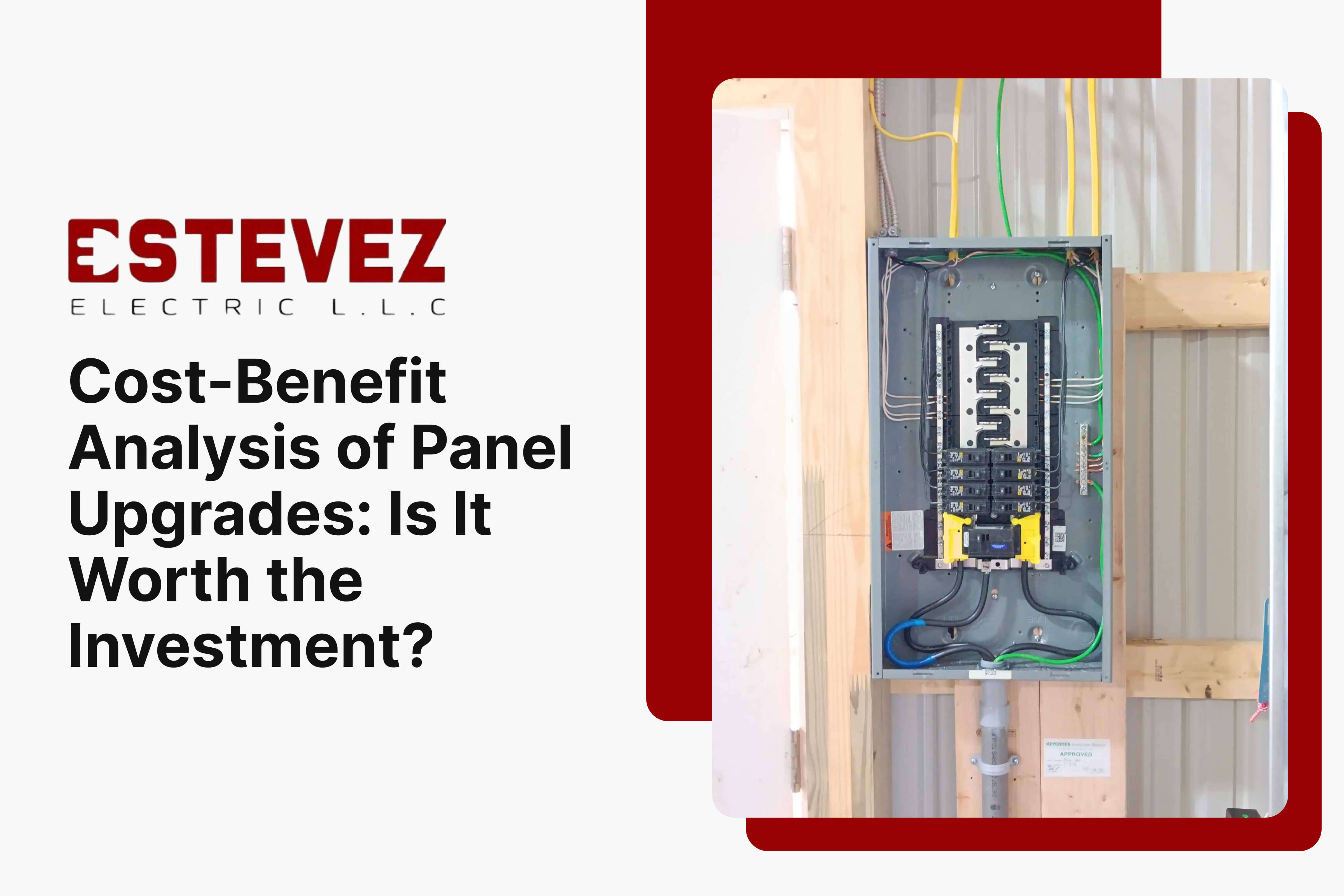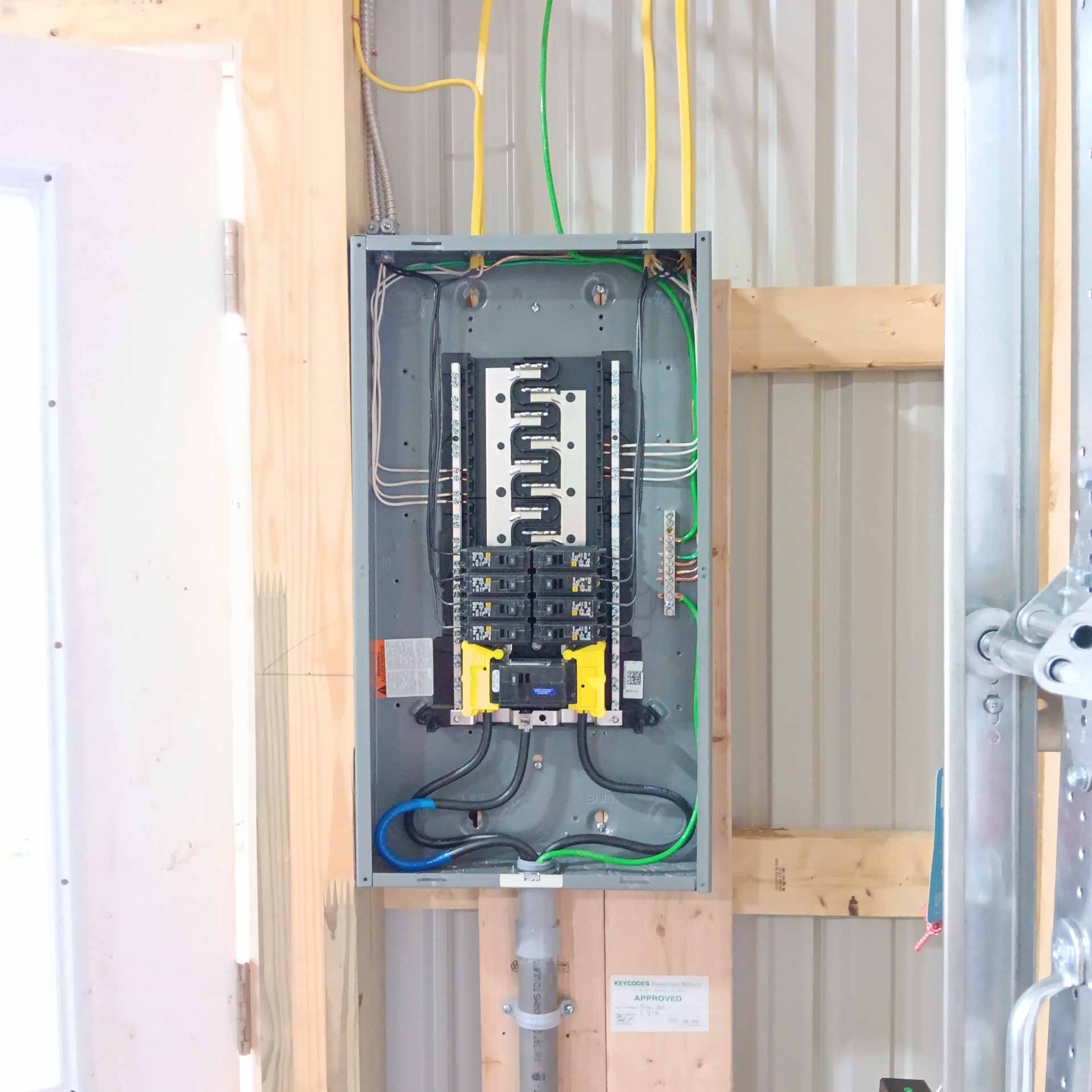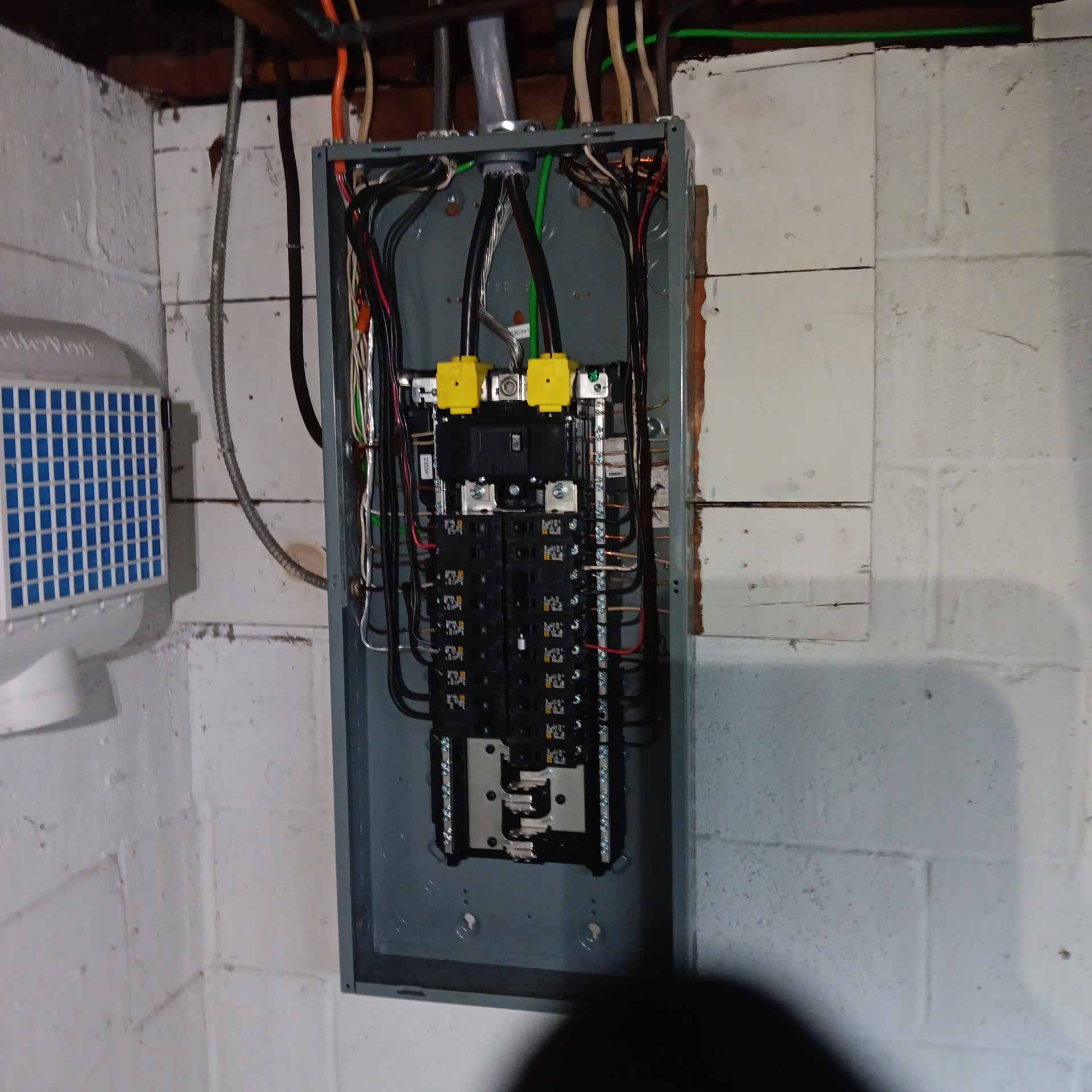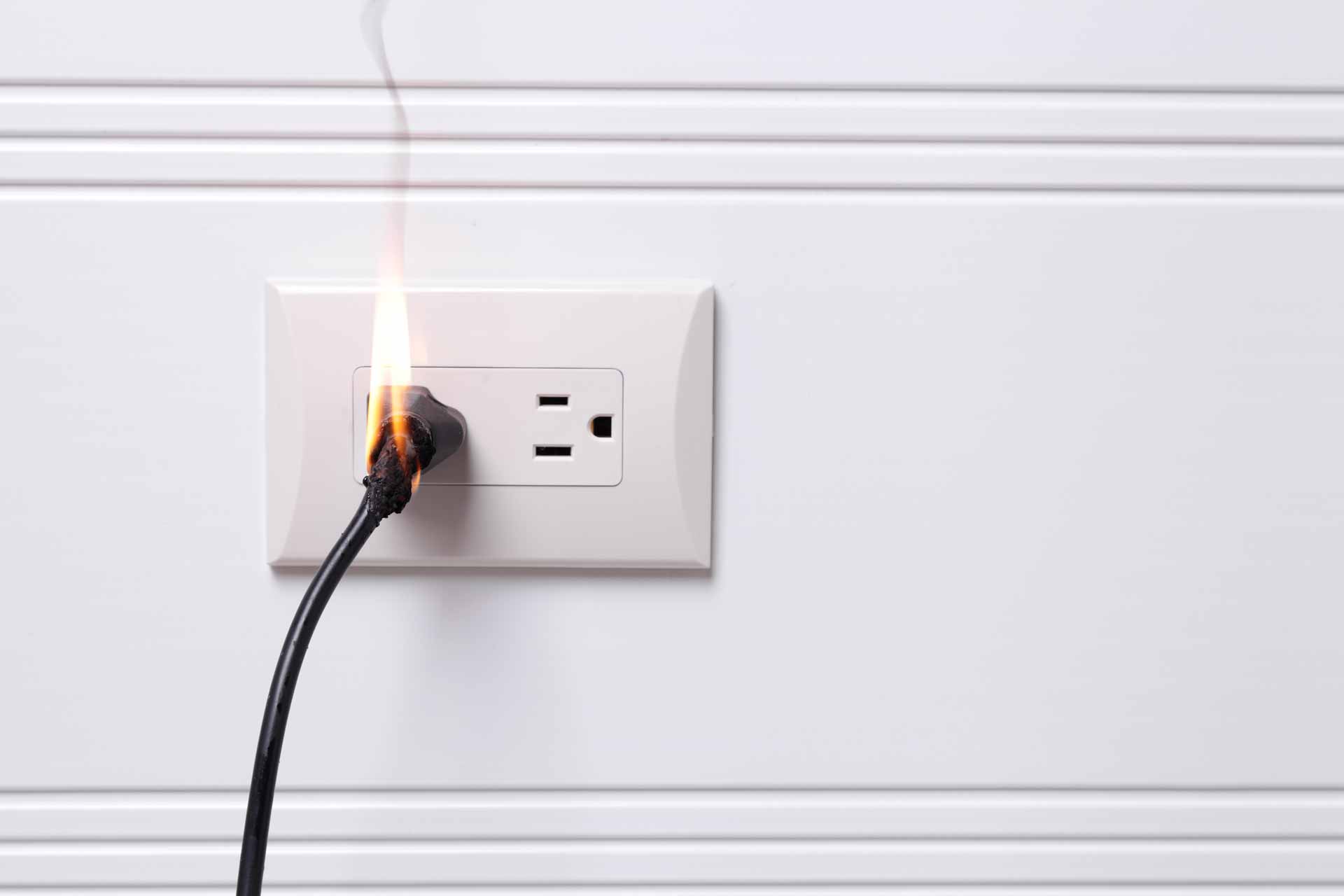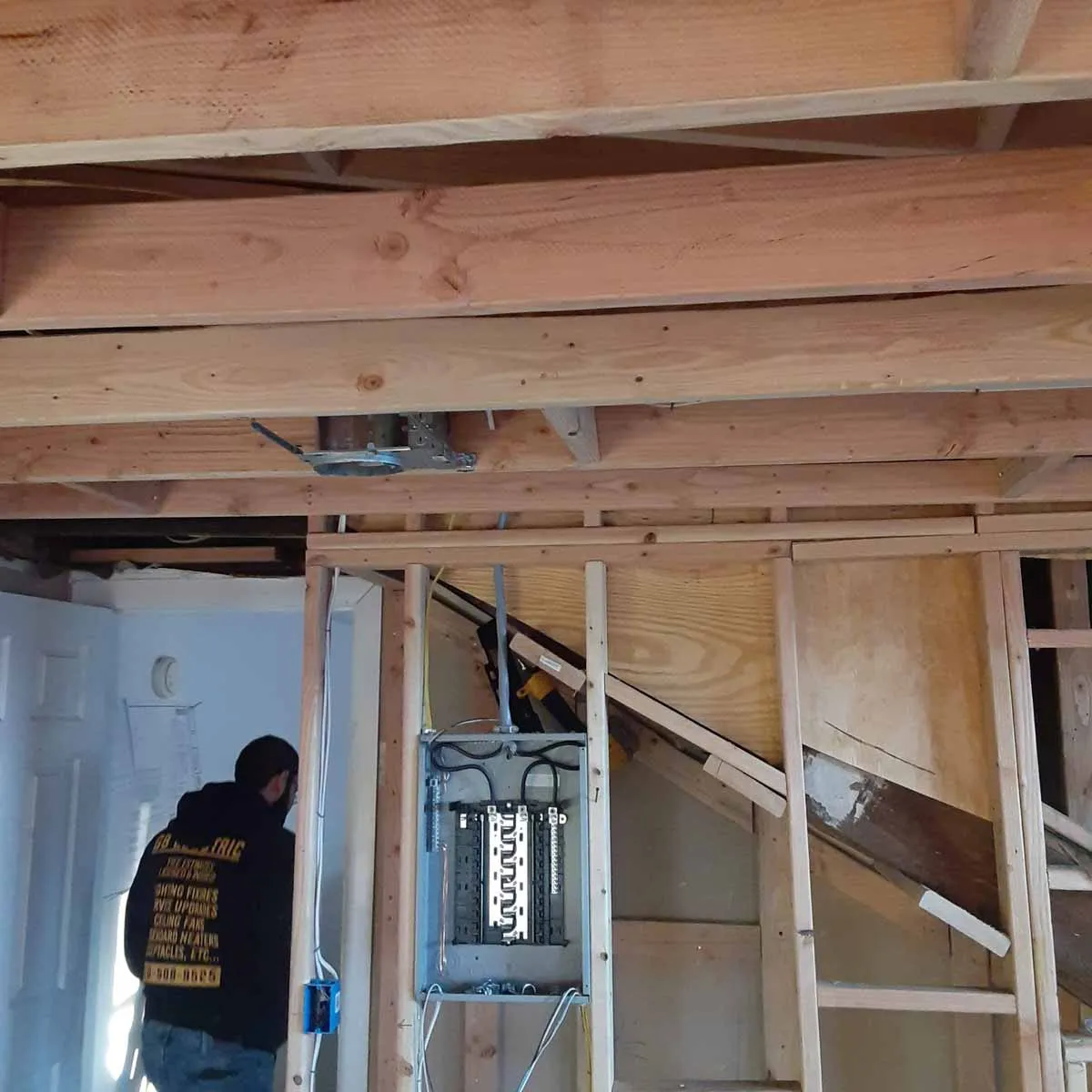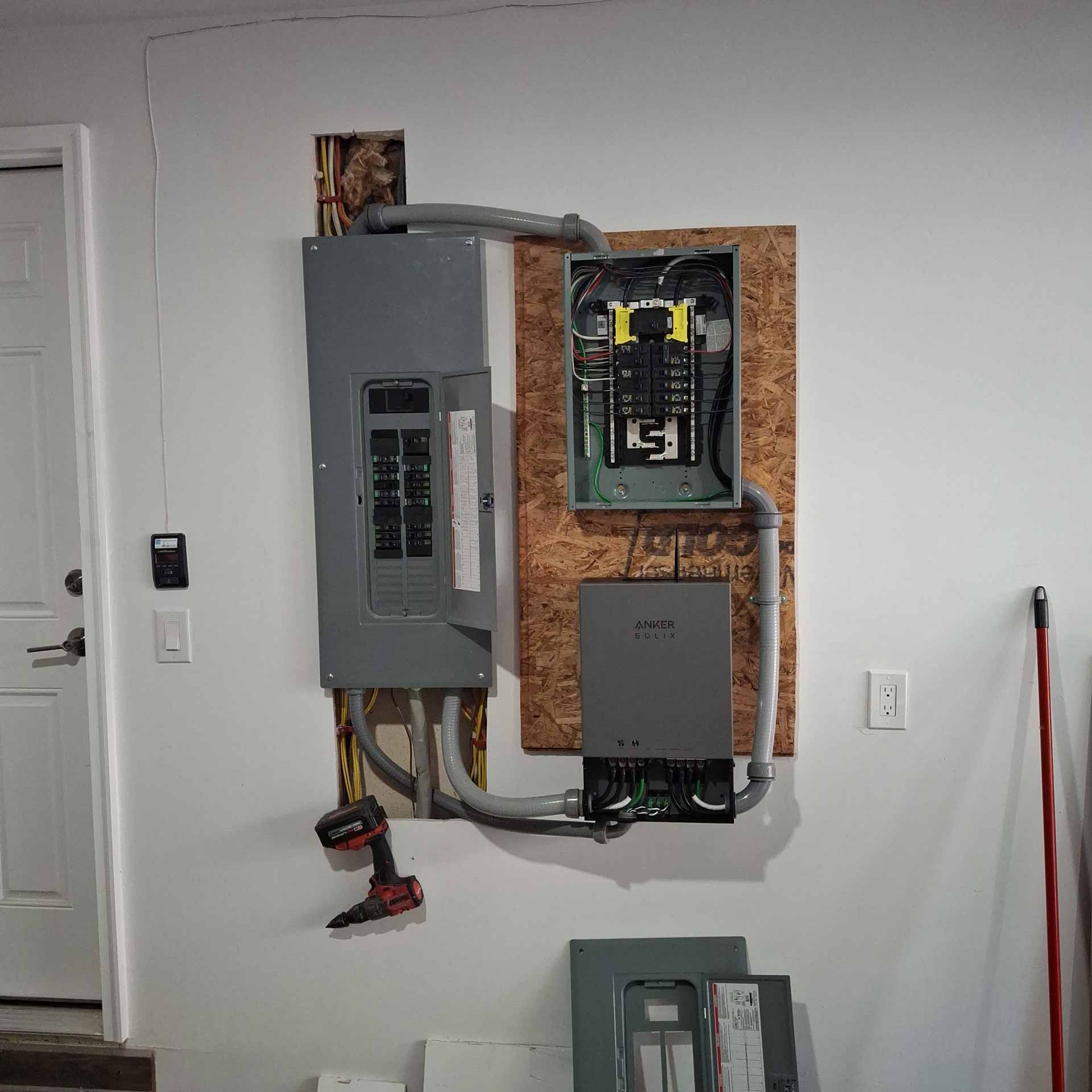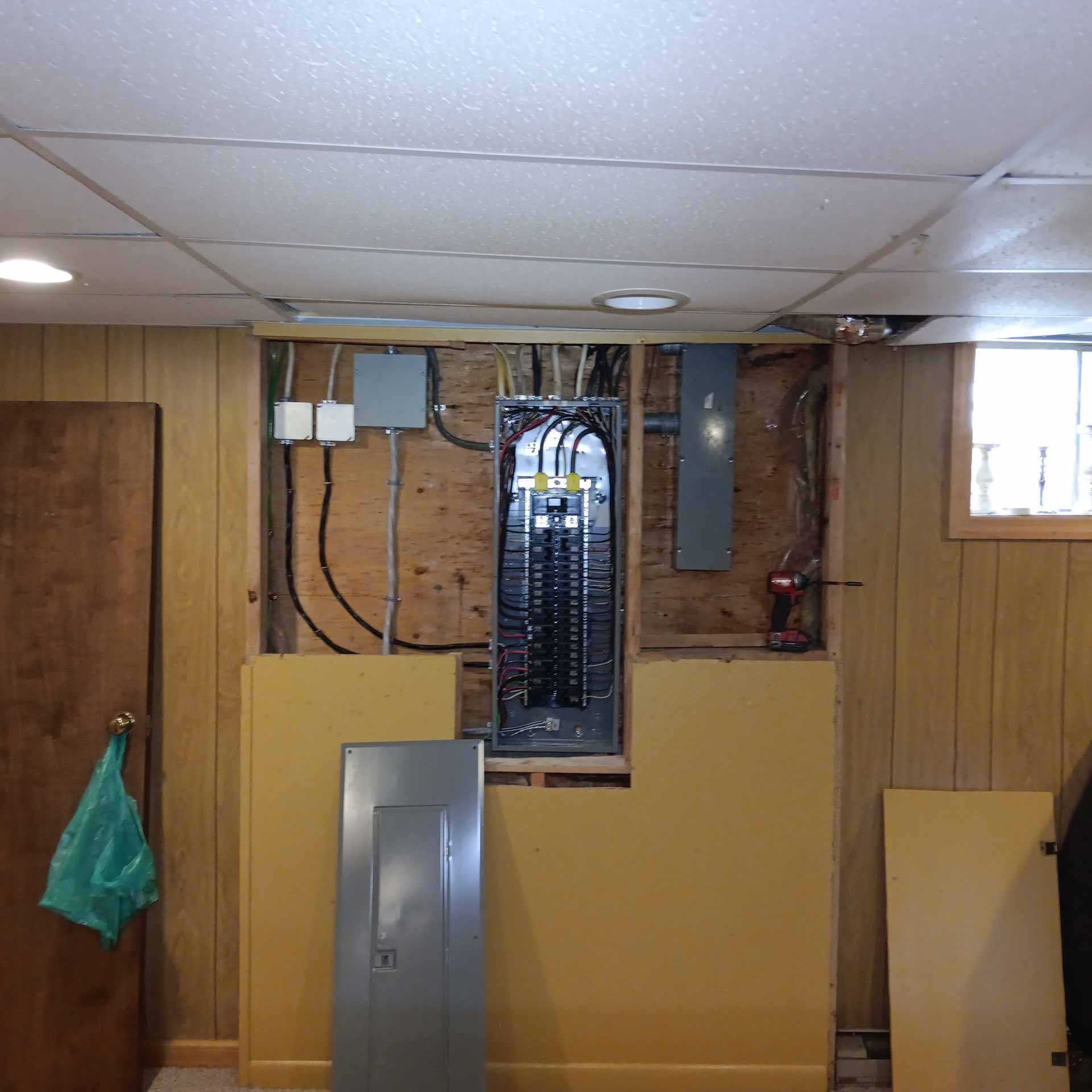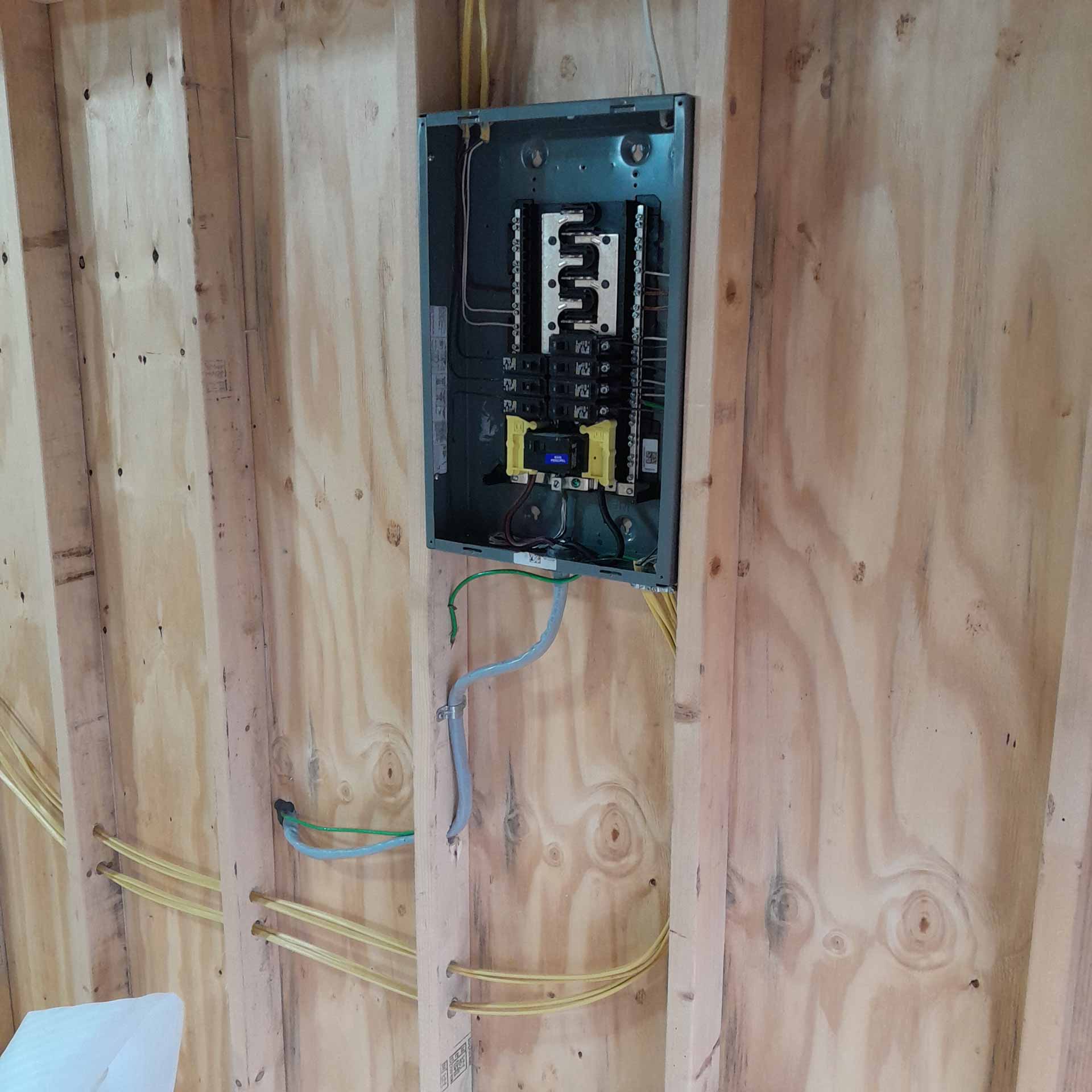Key Takeaways
- Electrical panel upgrades typically cost between $850 and $3,000 depending on amperage and complexity
- Modern homes generally require 200-amp service to handle today’s electrical demands
- Warning signs that indicate a panel upgrade is needed include frequent breaker trips, flickering lights, and burning smells
- Panel upgrades provide significant safety benefits by reducing fire risks and electrical hazards
- Upgrading your electrical panel can increase home value and support modern appliances and technology
- Professional installation by licensed electricians is essential for safety and code compliance
- Most homeowners see a positive return on investment through improved safety, functionality, and property value
- Insurance companies often offer premium discounts for homes with updated electrical systems
- Panel upgrades enable future home improvements and technology integration without additional electrical modifications
- The typical lifespan of a modern electrical panel is 25-40 years, making it a long-term investment
Understanding Electrical Panel Upgrades
An electrical panel serves as the central distribution point for all electricity in your home. As the command center of your electrical system, it routes power to various circuits throughout your house. Over time, these panels can become outdated, inefficient, or even dangerous as your home’s electrical needs evolve and technology advances. The panel’s primary function is to safely distribute incoming electricity to different areas of your home while providing protection through circuit breakers that automatically shut off power when overloads or faults are detected.
Many homeowners in Allentown and surrounding areas live in older homes with electrical panels that were installed decades ago. These aging systems were designed for much lower electrical demands than what modern households require. When these panels were originally installed, homes typically used only a fraction of the electricity that today’s households consume. Most older homes were built with 60-amp or 100-amp service, which was sufficient for basic lighting, a refrigerator, and perhaps a television or radio. Today’s homes are filled with high-powered appliances, entertainment systems, smart home devices, and multiple charging stations that simply didn’t exist when many electrical panels were installed, creating unprecedented demands on aging electrical infrastructure.
Professional electrical contractors like our team at Estevez Electric LLC frequently recommend panel upgrades when we notice potential safety hazards or inadequate power distribution during home inspections. A panel upgrade isn’t just about getting more power—it’s about ensuring your home’s electrical system is safe, efficient, and capable of supporting your lifestyle. Outdated panels often lack modern safety features such as ground fault circuit interrupters (GFCIs) and arc fault circuit interrupters (AFCIs) that provide crucial protection against electrical fires and shocks.
The decision to upgrade your electrical panel should be based on a thorough assessment of your current electrical needs, the condition of your existing panel, and your plans for future electrical usage. Factors such as the age of your home, the type of existing panel, visible signs of wear or damage, and your household’s growing power requirements all play important roles in determining whether an upgrade is necessary. In the following sections, we’ll explore the costs, benefits, and key considerations to help you determine if a panel upgrade is a worthwhile investment for your home.
Signs Your Home Needs an Electrical Panel Upgrade
Recognizing the warning signs that indicate your electrical panel needs an upgrade is crucial for maintaining both safety and functionality in your home. These indicators shouldn’t be ignored, as they often represent significant safety concerns that could put your family and property at risk. Here are the most common indicators that it’s time to consider upgrading your electrical panel:
Frequent Circuit Breaker Trips
If your circuit breakers trip regularly when you use multiple appliances simultaneously, this is a clear sign that your electrical panel is struggling to handle your home’s power demands. Modern households use significantly more electricity than homes did even 20 years ago, and an outdated panel may not be equipped to handle the load. When circuit breakers trip repeatedly, it’s not just an inconvenience—it’s your electrical system’s way of preventing dangerous overloads that could lead to overheating and fires. If you find yourself constantly resetting breakers or if certain appliances like microwaves, hair dryers, or air conditioners consistently cause trips when used with other devices, your panel is likely undersized for your current needs.
Flickering or Dimming Lights
When lights flicker or dim, especially when large appliances like air conditioners or refrigerators cycle on, it often indicates that your electrical panel isn’t distributing power effectively. This inconsistent power delivery can damage sensitive electronics and indicates your system is under strain. These fluctuations occur because your electrical system cannot maintain consistent voltage throughout your home when power-hungry appliances demand more electricity. The problem is particularly noticeable during peak usage times when multiple devices are operating simultaneously. Over time, these voltage fluctuations can shorten the lifespan of electronics and appliances, causing premature failures and potentially costly replacements.
As our electrical panel upgrade guide explains, flickering lights aren’t just an annoyance—they’re a warning sign that shouldn’t be ignored. They indicate an electrical system that’s struggling to meet demand and could eventually lead to more serious problems if not addressed.
Burning Smells or Visible Damage
Perhaps the most alarming signs are burning smells, discoloration around outlets, or scorch marks on the panel itself. These indicate dangerous overheating that could lead to an electrical fire. If you notice any of these signs, you should contact an emergency electrician immediately. The smell of burning plastic or unusual odors near your electrical panel, outlets, or switches should never be ignored, as they often indicate that wiring insulation is melting or burning—a serious fire hazard that requires immediate professional attention. Similarly, outlets or switches that are warm to the touch, discolored, or making buzzing sounds indicate dangerous conditions that could result in electrical fires.
Outdated Panel Technology
If your home still has a fuse box instead of circuit breakers, or if you have an older panel brand that has been recalled (like Federal Pacific Electric panels or Zinsco panels), an upgrade is not just recommended—it’s essential for safety. These outdated systems don’t provide adequate protection against electrical faults. Fuse boxes, while functional in their time, lack the safety features and capacity of modern circuit breaker panels. When a fuse blows, it must be replaced rather than simply reset, making them less convenient and more prone to improper replacements that compromise safety. Federal Pacific Electric panels, installed in millions of homes between the 1950s and 1980s, have been found to have a high failure rate where breakers don’t trip when they should, creating significant fire hazards.
Insufficient Outlets and Reliance on Extension Cords
When you find yourself constantly using power strips and extension cords to meet your electrical needs, it’s a sign that your electrical system wasn’t designed for your current usage. This makeshift solution creates fire hazards and indicates that your panel may need an upgrade to support additional circuits. Extension cords and power strips are intended for temporary use, not as permanent solutions to insufficient outlets. Overloaded power strips can overheat, damage connected devices, and potentially cause fires. Additionally, running extension cords under carpets or furniture creates hidden fire hazards as cords can become damaged and overheat without being visible. A properly upgraded electrical panel allows for the installation of additional circuits and outlets throughout your home, eliminating the need for these dangerous workarounds.
Planning Major Renovations or Adding New Appliances
If you’re planning a home renovation, adding a hot tub, electric vehicle charging station, or other high-powered appliances, you’ll likely need to upgrade your electrical panel to handle the increased load. As our guide to choosing the right electrical panel explains, planning ahead for these upgrades can save you time and money. Many modern conveniences such as electric vehicle chargers, hot tubs, workshop equipment, and smart home systems require dedicated circuits that older panels simply cannot accommodate. Upgrading your panel before installing these features ensures they’ll operate safely and efficiently without overloading your electrical system.
Recognizing these signs early can help you address electrical issues before they become dangerous or cause significant inconvenience. Our team at Estevez Electric LLC can provide a thorough assessment of your current electrical panel and recommend appropriate upgrades based on your specific needs. Being proactive about electrical system upgrades not only enhances safety but can prevent costly emergency repairs and potential damage to your home and valuable electronics.
Cost Breakdown of Electrical Panel Upgrades
Understanding the costs associated with electrical panel upgrades is essential for making an informed decision about this important home improvement. The investment varies based on several factors, including the amperage of the new panel, your home’s specific requirements, and local labor rates. While the upfront cost may seem significant, it’s important to view this as a long-term investment in your home’s safety, functionality, and value rather than merely an expense.
Typical Cost Ranges by Panel Size
According to our experience at Estevez Electric LLC, the cost of electrical panel upgrades typically falls within these ranges:
- 100-amp panel upgrade: $850-$1,600 – This is the minimum standard for very small homes or apartments with limited electrical needs. While less expensive initially, this option may not provide sufficient capacity for most modern households and could require another upgrade in the future.
- 200-amp panel upgrade: $1,800-$2,500 (most common for modern homes) – This has become the standard for contemporary homes, providing ample power for typical household needs including major appliances, entertainment systems, and home office equipment. The majority of our residential upgrades fall into this category as it offers the best balance of capacity and cost-effectiveness.
- 400-amp panel upgrade: $2,500-$4,000 (for larger homes with extensive electrical needs) – This higher-capacity option is typically recommended for larger homes (over 3,000 square feet), homes with all-electric heating systems, workshops with power tools, or properties with additional structures requiring power.
These prices reflect the total project cost, including materials, labor, and necessary permits. As our detailed cost breakdown explains, the 200-amp service has become the standard for most homes today, providing sufficient power for modern appliances and electronics. This mid-range option offers the best value for most homeowners, balancing adequate capacity with reasonable installation costs.
Factors That Influence Upgrade Costs
Several variables can affect the final cost of your electrical panel upgrade:
- Panel Location and Accessibility: If your panel is difficult to access or needs to be relocated, costs will increase due to additional labor and materials. Panels in crawl spaces, behind walls, or in other challenging locations require more time and effort to replace, potentially adding several hundred dollars to the project cost. Similarly, if code requirements necessitate moving the panel to a new location, this involves additional wiring and possibly wall repairs.
- Service Line Upgrades: Sometimes the utility company’s service lines to your home need upgrading to support a larger panel, adding to the overall cost. This may involve coordination with your local utility provider and could require trenching for underground lines or new overhead connections. While some utility companies cover part of these costs, homeowners are often responsible for a portion of service line upgrades.
- Home Age and Existing Wiring: Older homes may require additional wiring updates to bring the system up to code, increasing the project scope. Homes built before the 1960s often have outdated wiring methods or materials that don’t meet current safety standards. Addressing these issues during a panel upgrade is essential but adds to the overall investment.
- Permits and Inspections: These are mandatory for electrical panel upgrades and typically cost between $50 and $300, depending on your location. Local building departments require permits to ensure work meets current electrical codes, and inspections are necessary to verify compliance before the system can be fully activated.
Additional Costs to Consider
Beyond the basic panel upgrade, there are several related services you might need:
- Whole-house surge protection: $300-$500 (highly recommended with new panels) – This system protects all electronics and appliances in your home from damaging power surges, potentially saving thousands in equipment replacement costs. Unlike plug-in surge protectors, whole-house systems protect everything connected to your electrical system simultaneously.
- GFCI/AFCI breaker upgrades: $40-$60 per breaker (important for safety in kitchens, bathrooms, and other areas) – These specialized circuit breakers provide enhanced protection against electrical shocks and fires. Current electrical codes require them in specific locations, and adding them during a panel upgrade is more cost-effective than installing them later.
- Subpanel installation: $500-$1,000 (if needed for specific areas like workshops or additions) – Subpanels provide additional circuit capacity for areas far from the main panel or spaces with concentrated electrical needs, such as workshops, garages, or home additions.
As licensed electrical contractors, we always provide detailed, transparent quotes that outline all potential costs before beginning work. This ensures there are no surprises when the project is complete. Our estimates include all aspects of the job from permits and materials to labor and final inspections, giving you a clear understanding of the total investment required.
Long-Term Cost Considerations
While the upfront cost of an electrical panel upgrade may seem significant, it’s important to consider the long-term financial implications:
- Insurance savings: Many insurance companies offer reduced premiums for homes with updated electrical systems. Some homeowners report savings of 5-20% on their homeowner’s insurance after documenting electrical upgrades, which can recover a significant portion of the upgrade cost over time.
- Energy efficiency: Modern panels can operate more efficiently, potentially reducing your monthly utility bills. By providing more stable power delivery, new panels help appliances operate at optimal efficiency, potentially saving 5-10% on electricity costs.
- Avoiding emergency repairs: Proactively upgrading an aging panel is typically less expensive than emergency repairs after a failure. Emergency electrical work often comes with premium pricing, and damage from electrical failures can be extensive and costly to repair.
Our electrical maintenance guide provides additional insights into how preventative upgrades can save money over time. Many homeowners find that the combination of increased safety, improved functionality, potential insurance savings, and avoided emergency repairs makes the investment in a panel upgrade financially sound over the long term.
Understanding these costs helps you budget appropriately for this essential home improvement project. In the next section, we’ll explore the benefits that make this investment worthwhile for many homeowners.
Benefits of Upgrading Your Electrical Panel
Investing in an electrical panel upgrade delivers numerous advantages that extend beyond simply having more power. These benefits impact your home’s safety, functionality, value, and your daily quality of life. Let’s explore the key benefits that make this upgrade a worthwhile consideration for homeowners.
Enhanced Safety and Fire Prevention
The most critical benefit of a panel upgrade is improved safety. Outdated electrical panels can pose serious fire hazards, especially when they’re forced to handle more power than they were designed for. According to the National Fire Protection Association, electrical failures or malfunctions are a leading cause of residential fires, resulting in hundreds of deaths and over a billion dollars in property damage annually. Modern panels significantly reduce these risks through improved design and advanced safety features.
Modern electrical panels include advanced safety features like:
- AFCI protection: Detects dangerous electrical arcs that can cause fires. These specialized breakers can identify minute electrical arcs in wiring that standard breakers cannot detect, shutting off power before these arcs can ignite surrounding materials.
- GFCI protection: Prevents electrical shocks in wet areas by detecting ground faults and cutting power in as little as 1/40 of a second—fast enough to prevent serious injury or death from electrical shock.
- More precise circuit breakers: Trip faster when overloads occur, reducing fire risks. Modern breakers are calibrated to respond more quickly to dangerous conditions and are manufactured with higher quality standards than older models.
As our guide to panel upgrade signs explains, these safety improvements alone make the upgrade worthwhile for many homeowners, especially those with aging electrical systems. The peace of mind that comes from knowing your electrical system meets current safety standards is invaluable, particularly for families with children or homes with elderly residents.
Increased Capacity for Modern Living
Today’s homes use significantly more electricity than homes did even a decade ago. The average American household now has dozens of electronic devices and appliances that didn’t exist or weren’t common when many electrical systems were installed. A modern 200-amp panel provides sufficient power for:
- Multiple high-powered kitchen appliances including refrigerators, dishwashers, microwaves, induction cooktops, and specialty appliances that have become kitchen staples
- Electric vehicle charging stations, which can draw 30-50 amps when charging—a significant load that older panels cannot safely accommodate
- Home office equipment including computers, printers, monitors, and other devices that have become essential as more people work from home
- Entertainment systems with multiple televisions, gaming consoles, sound systems, and streaming devices that collectively draw substantial power
- Smart home technology including security systems, automated lighting, climate control systems, and voice-activated assistants that require constant power
- HVAC systems and water heaters, which are among the highest energy consumers in most homes and often require dedicated circuits
With a panel upgrade, you’ll no longer need to worry about which appliances can run simultaneously or experience the frustration of frequently tripped breakers. This improved capacity translates to greater convenience and flexibility in how you use electricity throughout your home, eliminating the need to consciously manage which devices are operating at any given time.
Improved Home Value and Marketability
Updated electrical systems significantly enhance your home’s value and appeal to potential buyers. In our experience at Estevez Electric LLC, homes with modern electrical panels tend to:
- Sell faster than comparable homes with outdated electrical systems, as buyers increasingly prioritize move-in ready properties with updated infrastructure
- Pass home inspections more easily, avoiding last-minute negotiations or deal-breakers that often arise when inspection reports flag electrical concerns
- Command higher selling prices, with many real estate professionals estimating that electrical upgrades can return 80-100% of their cost through increased home value
- Appeal to a broader range of buyers, including those with high-tech needs, young families concerned about safety, and discerning buyers who recognize the value of updated systems
Real estate professionals consistently rank electrical system updates among the home improvements that offer the best return on investment, as they address both safety concerns and practical functionality. Unlike cosmetic upgrades that may fall out of style, electrical improvements represent lasting value that benefits any homeowner regardless of their design preferences.
Energy Efficiency Improvements
Modern electrical panels distribute power more efficiently throughout your home, which can result in energy savings. While the panel itself doesn’t directly reduce energy consumption, it enables:
- More efficient operation of appliances through stable power delivery, allowing them to function as designed without voltage fluctuations that can increase energy consumption
- Installation of energy monitoring systems that help you track and optimize electricity usage throughout your home
- Support for smart home energy management solutions that automatically adjust energy usage based on occupancy, time of day, or utility rates
- Proper power distribution that reduces waste from overloaded circuits and improves the overall efficiency of your electrical system
Support for Future Home Improvements
A panel upgrade provides the electrical foundation needed for future home improvements and additions. Whether you’re planning a kitchen renovation, adding a home office, or installing a hot tub, having sufficient electrical capacity makes these projects simpler and less expensive. Without adequate panel capacity, each new electrical project might require expensive modifications to your electrical system, potentially doubling the cost of these improvements. An upgraded panel essentially future-proofs your home, allowing you to adapt to changing technologies and lifestyle needs without electrical constraints.
Our guide to electrical service upgrades highlights how a panel upgrade now can save you money on future projects by eliminating the need for electrical system modifications later. This is particularly valuable for homeowners planning to stay in their homes long-term, as it provides the flexibility to evolve your living space as needs change.
Peace of Mind
Perhaps the most valuable benefit is the peace of mind that comes from knowing your home’s electrical system is safe, reliable, and capable of meeting your needs. Homeowners who upgrade their panels report:
- Reduced worry about electrical fires, which is especially important for families with children or elderly residents
- Less frustration with power limitations, eliminating the daily inconvenience of tripped breakers and power management
- Confidence in their home’s safety, particularly during severe weather events when electrical systems are under additional stress
- Satisfaction with improved functionality, allowing them to fully enjoy modern conveniences without electrical constraints
These benefits make electrical panel upgrades one of the most practical and valuable home improvements you can make, especially if your current panel shows any of the warning signs we discussed in previous sections. Unlike many home improvements that focus solely on aesthetics, panel upgrades deliver tangible benefits in safety, functionality, and long-term value that impact your daily quality of life.
Comparing Panel Upgrade Options: What’s Right for Your Home?
When considering an electrical panel upgrade, it’s important to understand the different options available and determine which one best suits your home’s specific needs. The right choice depends on your current electrical usage, future plans, home size, and budget considerations. Let’s explore the main panel types and help you make an informed decision.
Understanding Amperage Options
The amperage rating of your electrical panel determines how much power it can safely distribute throughout your home. Think of amperage as the electrical system’s capacity—similar to how the diameter of a water pipe determines how much water can flow through it. Here’s a breakdown of the common options:
100-Amp Service
- Best for: Small homes (under 1,000 square feet) with minimal electrical demands, such as apartments, small condos, or cottages with few major appliances
- Limitations: May struggle with multiple high-powered appliances running simultaneously. Typically cannot support electric vehicle charging, electric heating systems, or extensive modern electronics
- Cost-effectiveness: Lowest upfront cost but may need upgrading sooner as electrical needs increase. This can make it less economical in the long run if your electrical needs grow
200-Amp Service
- Best for: Most modern homes (1,000-3,000 square feet) with typical electrical demands including major appliances, HVAC systems, and modern electronics
- Advantages: Handles multiple appliances, electric heating/cooling, and modern electronics without strain. Provides sufficient capacity for most households without requiring careful power management
- Future-proofing: Provides capacity for most future additions and upgrades, including electric vehicle chargers, home additions, and new appliances
- Standard choice: Recommended by our electrical contractors for most residential upgrades due to its optimal balance of capacity and cost
400-Amp Service
- Best for: Large homes (over 3,000 square feet), luxury homes with extensive electrical needs, or properties with workshops/outbuildings that require significant power
- Advantages: Supports maximum electrical capacity for even the most demanding households, including multiple electric vehicles, all-electric heating/cooling, hot tubs, workshops, and smart home systems
- Implementation: Often installed as two 200-amp panels working together, providing redundancy and allowing for more precise circuit organization
- Cost consideration: Highest upfront investment but maximum future-proofing for homes with extensive electrical needs or plans for significant expansion
Panel Features to Consider
Beyond amperage, there are several important features to consider when selecting a new electrical panel:
Circuit Capacity
The number of circuits your panel can accommodate affects how specifically you can control different areas of your home. More circuits allow for:
- Dedicated lines for major appliances, ensuring they receive consistent power without affecting other devices
- Separate circuits for specific rooms or areas, allowing for more precise control and troubleshooting
- Better isolation of electrical problems, making it easier to identify and address issues without disrupting the entire home
- More precise control over your home’s electrical system, with the ability to shut off power to specific areas while maintaining service elsewhere
Built-in Safety Features
Modern panels offer advanced safety features that older models lack:
- GFCI/AFCI Protection: These specialized circuit breakers provide enhanced protection against shocks and fires. GFCI breakers detect ground faults that could cause electrocution, while AFCI breakers identify arc faults that could cause fires
- Surge Protection: Some panels include whole-house surge protection to safeguard electronics from lightning strikes and power surges, potentially saving thousands in equipment replacement costs
- Smart Monitoring: Advanced panels may include monitoring capabilities to track electrical usage and detect potential problems before they cause damage or create safety hazards
Panel Brand and Quality
Not all electrical panels are created equal. At Estevez Electric LLC, we recommend and install high-quality panels from reputable manufacturers known for reliability and safety. While premium panels may cost more initially, they typically offer:
- Longer warranties, often 10-25 years compared to 1-5 years for economy models
- Better performance with more precise circuit protection and fewer nuisance trips
- Enhanced durability with components designed to withstand decades of use without degradation
- Superior safety features that exceed minimum code requirements, providing additional protection for your home and family
Making the Right Choice for Your Home
To determine the best panel upgrade option for your specific situation, consider these factors:
- Current and Future Electrical Needs: Assess not just your current usage but anticipated needs over the next 15-20 years. Will you be adding electric vehicles, home additions, or major appliances? Are you planning to install solar panels or other renewable energy systems? Thinking ahead can prevent the need for another upgrade in the near future.
- Home Size and Layout: Larger homes or those with detached structures may benefit from higher amperage or subpanels. Consider the distance between your main panel and areas with high electrical demands, as voltage drop over long distances can affect performance.
- Budget Constraints: Balance upfront costs against long-term benefits and future-proofing. While a larger panel costs more initially, it may be more economical than multiple upgrades over time if your electrical needs are likely to increase.
- Local Electrical Codes: Some municipalities have specific requirements for residential electrical systems that may influence your decision. Local building codes may mandate certain features or minimum amperage based on your home’s size and specifications.
Our professional electricians can provide a comprehensive assessment of your home’s electrical needs and recommend the most appropriate panel upgrade option. We consider your current usage patterns, future plans, and budget constraints to help you make the most informed decision possible. This personalized approach ensures you get exactly what your home needs—not more than necessary, but sufficient for both current requirements and reasonable future growth.
In most cases, we recommend at least a 200-amp service for modern homes, as this provides sufficient capacity for typical electrical needs while allowing room for future expansion. However, every home is unique, and our recommendations are always tailored to your specific situation. Factors such as all-electric heating, hot tubs, workshop equipment, or plans for electric vehicle charging might necessitate higher capacity options for optimal performance and safety.
The Panel Upgrade Process: What to Expect
Understanding what happens during an electrical panel upgrade can help you prepare for the project and ensure it goes smoothly. At Estevez Electric LLC, we follow a comprehensive process to ensure safety, compliance, and customer satisfaction. This systematic approach minimizes disruption while delivering a high-quality installation that will serve your home for decades.
Pre-Installation Assessment and Planning
Before any work begins, our process includes:
- Comprehensive Home Electrical Assessment: We evaluate your current electrical usage, inspect your existing panel, and identify any potential issues or code violations. This thorough assessment includes examining the condition of your service entrance cable, grounding system, and circuit distribution to develop a complete picture of your electrical system’s current state.
- Customized Upgrade Plan: Based on our assessment, we develop a detailed plan that includes panel specifications, circuit requirements, and any additional work needed to bring your system up to code. This plan considers your specific needs, budget constraints, and any unique characteristics of your home that might affect the installation process.
- Permit Acquisition: We handle all necessary permits required by local building departments. This step is crucial as unpermitted electrical work can create insurance and liability issues. Working without proper permits can void insurance coverage and create complications when selling your home, so we ensure all work is properly documented and approved.
- Utility Coordination: We coordinate with your utility company regarding any service disconnections or upgrades needed from their end. This often requires scheduling specific appointment times with the utility provider, which we manage to minimize inconvenience to you.
- Schedule Planning: We work with you to schedule the upgrade at a convenient time, explaining how long power will be off and helping you prepare. We provide recommendations for managing without electricity during the installation period, including food storage, alternative lighting, and other practical considerations.
The Installation Day: Step-by-Step
On the day of installation, here’s what you can expect:
- Power Disconnection: Your power will be shut off at the beginning of the project. This typically happens early in the morning to maximize daylight working hours. Depending on your utility company’s policies, either their technician will disconnect power at the meter or our electricians will handle this step after confirming it’s safe to proceed.
- Removal of Old Panel: The existing panel is carefully disconnected and removed, with special attention to preserving circuit connections for reinstallation. Our technicians document the existing circuit configuration to ensure proper reconnection in the new panel, taking photographs and creating detailed notes about the current setup.
- Installation of New Panel: The new panel is mounted securely, and all circuit breakers are installed according to the planned configuration. This includes proper attachment to wall studs or other structural elements to ensure stability, as well as precise alignment and leveling for both functional and aesthetic purposes.
- Circuit Reconnection and Labeling: All circuits are properly reconnected to the new panel and clearly labeled for future reference. This detailed labeling system makes it easy to identify which breaker controls each area of your home, simplifying future troubleshooting and maintenance.
- Grounding System Verification: We ensure your electrical system is properly grounded according to current electrical codes. This critical safety feature provides a path for fault currents to safely dissipate, protecting both people and equipment from electrical hazards.
- Safety Testing: Before restoring power, comprehensive safety tests are conducted to verify all connections are secure and functioning correctly. These tests include checking for proper voltage at various points, ensuring correct polarity, and verifying that safety devices like GFCI and AFCI breakers operate as intended.
- Power Restoration: Once testing is complete, power is restored to your home, and each circuit is verified for proper operation. Our technicians methodically check every outlet, switch, and fixture to confirm they’re receiving power and operating correctly.
Post-Installation Services
After your panel upgrade is complete, we provide:
- Final inspection scheduling: We coordinate with local building inspectors to ensure your upgrade meets all code requirements. This official inspection is necessary to confirm the work complies with electrical safety standards and local regulations.
- System walkthrough: We explain how your new panel operates, including how to reset breakers and identify circuit functions. This education helps you maintain your system and troubleshoot minor issues independently.
- Circuit directory completion: We provide a detailed directory of all circuits, making future electrical work easier. This comprehensive guide identifies exactly what each breaker controls, eliminating guesswork for future maintenance or modifications.
- Warranty documentation: We provide complete warranty information for both our work and the panel components. Our warranties typically cover both labor and materials for an extended period, giving you peace of mind about your investment.
- Maintenance recommendations: We offer guidance on maintaining your new electrical panel for optimal performance and longevity. Regular maintenance can extend the life of your panel and help prevent future problems.
Timeline and Power Outage Expectations
Most panel upgrades can be completed in 4-8 hours, though complex installations may take longer. During this time:
- Full power outage: Your home will be without electricity during the majority of the installation process. We recommend planning accordingly by having flashlights, battery-powered devices, and alternative arrangements for any critical electrical needs.
- Temporary inconveniences: Plan for no refrigeration, air conditioning, or electrical appliances during the work period. If the installation spans multiple days due to complexity, we may be able to provide temporary power solutions for essential needs.
- Communication: Our team keeps you informed throughout the process, providing regular updates on progress and any unexpected issues that may arise. We believe in transparent communication to ensure you’re never left wondering what’s happening with your project.
Preparing for Your Panel Upgrade
To ensure your panel upgrade goes smoothly, we recommend:
- Clear the area: Remove items from around your electrical panel to provide easy access for our technicians. This includes moving furniture, decorations, or storage items that might obstruct the work area.
- Backup important data: Save any computer work and charge devices in advance, as power interruptions can cause data loss. Consider backing up important files to cloud storage or external drives before the installation begins.
- Plan meals: Arrange for meals that don’t require cooking, as your stove and other kitchen appliances will be unavailable. This might be a good day for takeout or pre-prepared meals that don’t require heating.
- Alternative lighting: Have flashlights, battery-powered lanterns, or other portable lighting ready for the evening if work extends into dark hours. Cell phone flashlights can be helpful, but dedicated lighting sources are more convenient for extended periods.
- Pet considerations: Plan for pet care, as the work area and noise may disturb animals. Some pets may be more comfortable staying elsewhere during the installation, while others may simply need a quiet room away from the work area.
Our team at Estevez Electric LLC is committed to making your panel upgrade as smooth and convenient as possible. We understand that having your power disconnected is disruptive, so we work efficiently while maintaining the highest safety and quality standards. Our experienced technicians have completed hundreds of panel upgrades and can handle unexpected challenges that may arise during the installation process.
Return on Investment: Is a Panel Upgrade Worth It?
When evaluating whether an electrical panel upgrade is a worthwhile investment, it’s important to consider both the immediate and long-term financial implications. While the upfront cost can seem significant, the benefits often far outweigh the initial expense when viewed from a comprehensive perspective. Let’s examine the various ways a panel upgrade provides value to homeowners.
Financial Returns
The financial benefits of an electrical panel upgrade extend beyond simple home value appreciation:
- Home value increase: Updated electrical systems typically add 80-100% of their cost to your home’s value. Real estate professionals consistently rank electrical upgrades among the improvements with the highest return on investment, as they address critical safety and functionality concerns that matter to all buyers.
- Insurance premium reductions: Many insurance companies offer discounts of 5-20% for homes with updated electrical systems. These savings can amount to hundreds of dollars annually, helping to offset the upgrade cost over time. Some insurers may even require electrical updates before providing coverage for older homes.
- Avoided emergency repair costs: Proactive panel upgrades typically cost less than emergency repairs after a system failure. Emergency electrical work often comes with premium pricing, and electrical failures can cause additional damage to appliances, electronics, and even structural components of your home.
- Energy efficiency gains: While modest, the improved power distribution of modern panels can reduce electricity costs by 5-10% through more efficient appliance operation and reduced power waste from overloaded circuits.
Safety Value: Priceless Protection
The safety benefits of a panel upgrade provide value that’s difficult to quantify but incredibly important:
- Fire prevention: Electrical failures cause thousands of house fires annually. The advanced safety features in modern panels, including AFCI and GFCI protection, significantly reduce fire and shock risks. The cost of a panel upgrade pales in comparison to potential fire damage, which can destroy a home and endanger lives.
- Family protection: Updated electrical systems with proper grounding and modern safety features provide crucial protection against electrical shocks and electrocution. This protection is especially valuable for families with children or elderly residents who may be more vulnerable to electrical hazards.
- Equipment protection: Stable power delivery protects valuable electronics and appliances from damage caused by voltage fluctuations. The cost of replacing damaged devices often exceeds the price of a panel upgrade, making it a smart preventive investment.
Convenience and Quality of Life Improvements
The daily benefits of an upgraded panel contribute to its overall value:
- Elimination of power management: No more carefully timing appliance use or dealing with frequently tripped breakers. This convenience factor improves daily quality of life and reduces frustration with your home’s electrical system.
- Support for modern lifestyle: Adequate electrical capacity allows you to fully utilize modern conveniences including home offices, entertainment systems, smart home technology, and electric vehicle charging without limitations.
- Future-proofing: An upgraded panel provides the electrical foundation needed for future home improvements and technology adoption. This flexibility prevents the need for costly electrical modifications during future renovation projects.
Market Considerations
From a real estate perspective, panel upgrades offer several advantages:
- Faster sale times: Homes with updated electrical systems typically sell more quickly than those with outdated panels. Buyers increasingly prioritize move-in ready properties with updated infrastructure, viewing electrical upgrades as essential rather than optional.
- Broader buyer appeal: Modern electrical systems appeal to a wider range of potential buyers, including tech-savvy professionals, young families, and discerning buyers who recognize the value of updated infrastructure.
- Smoother inspections: Updated panels help homes pass inspection more easily, avoiding last-minute negotiations or deal complications that can arise when inspectors flag electrical concerns.
- Competitive advantage: In competitive real estate markets, homes with updated electrical systems have an advantage over similar properties with outdated infrastructure.
Long-Term Value Perspective
When evaluating the investment over the typical 25-40 year lifespan of a modern electrical panel:
- Cost per year: A $2,000 panel upgrade that lasts 30 years costs approximately $67 per year—less than many monthly utility bills and far less than most homeowners spend on discretionary purchases.
- Inflation hedge: Electrical work costs tend to increase with inflation, so upgrading now protects against higher future costs. Delaying necessary electrical work often results in higher total costs due to both inflation and the complexity of emergency repairs.
- Technology compatibility: Modern panels are designed to accommodate future electrical technologies, potentially eliminating the need for additional upgrades as new devices and systems become available.
Scenarios Where Panel Upgrades Provide Maximum Value
Certain situations make panel upgrades particularly valuable investments:
- Older homes: Properties with electrical systems over 25 years old typically see the greatest return on panel upgrade investments, as they address both safety concerns and functional limitations.
- Active real estate markets: In competitive housing markets, updated electrical systems can be the differentiating factor that helps a home sell quickly and at full asking price.
- High-tech households: Families with extensive electronics, home offices, or plans for electric vehicles benefit greatly from the increased capacity and stability of modern panels.
- Long-term homeowners: If you plan to stay in your home for many years, the comfort, safety, and convenience benefits provide ongoing value that justifies the investment.
Our experience at Estevez Electric LLC consistently shows that homeowners who invest in panel upgrades are satisfied with their decision. The combination of improved safety, enhanced functionality, potential insurance savings, and increased home value creates a compelling value proposition that extends far beyond the initial investment cost.
Conclusion: Making the Right Decision for Your Home
After examining the costs, benefits, and considerations surrounding electrical panel upgrades, it’s clear that this investment offers significant value for most homeowners with aging electrical systems. The decision ultimately comes down to your specific situation, but the evidence strongly supports upgrading panels that show warning signs or cannot meet modern electrical demands.
Key Decision Factors
When deciding whether to upgrade your electrical panel, consider these critical factors:
- Safety is paramount: If your panel shows any signs of danger—burning smells, scorch marks, frequent trips, or outdated technology—an upgrade isn’t optional; it’s essential for protecting your family and property.
- Current functionality: Are you constantly managing which appliances can run simultaneously? Do you rely heavily on extension cords and power strips? These inconveniences indicate your electrical system needs updating.
- Future plans: Whether you’re planning renovations, adding electric vehicles, or installing major appliances, adequate electrical capacity is essential. Upgrading your panel now prevents more expensive modifications later.
- Home age and value: Older homes with original electrical systems typically benefit most from panel upgrades, both in terms of safety improvements and return on investment.
For most homeowners with panels over 25 years old or those showing signs of inadequacy, electrical panel upgrades represent one of the most practical and valuable home improvements available. The investment typically pays for itself through improved safety, enhanced functionality, potential insurance savings, and increased home value. More importantly, it provides peace of mind knowing your home’s electrical system can safely support your modern lifestyle.
The typical cost of $1,800-$2,500 for a 200-amp panel upgrade is modest compared to the potential costs of electrical fires, emergency repairs, or the limitations of an inadequate electrical system. When spread over the 25-40 year lifespan of a modern panel, the annual cost is negligible compared to the benefits provided.
If you’re experiencing any of the warning signs discussed in this guide or simply want to ensure your home’s electrical system is safe and adequate, we recommend starting with a professional assessment. At Estevez Electric LLC, our experienced electricians can evaluate your current system and provide personalized recommendations based on your specific needs and circumstances.
Don’t wait for an electrical emergency to force your hand. Proactive panel upgrades are safer, less expensive, and more convenient than reactive emergency repairs. Your family’s safety, your home’s functionality, and your peace of mind are worth the investment in a modern, reliable electrical system.
Contact our team today to schedule an assessment and take the first step toward a safer, more capable electrical system that will serve your home reliably for decades to come. With proper professional installation and quality components, an electrical panel upgrade is an investment that delivers immediate benefits and long-term value, making it one of the smartest home improvements you can make.
Based on our extensive experience helping homeowners throughout the Allentown area, we strongly recommend electrical panel upgrades for:
- Any home with a panel over 25 years old
- Properties showing warning signs like frequent breaker trips, flickering lights, or burning smells
- Homes with outdated fuse boxes or recalled panel brands
- Households planning major electrical additions or renovations
- Families prioritizing safety and modern functionality
The question isn’t whether you can afford to upgrade your electrical panel—it’s whether you can afford not to. The safety, functionality, and value benefits make this investment a clear choice for most homeowners with aging electrical systems. Your home’s electrical panel is the foundation of your electrical system; make sure it’s built to support your modern lifestyle safely and reliably.

